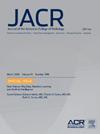在全国肺癌筛查登记中,阳性筛查比在全国肺癌筛查试验中更有可能。
IF 4
3区 医学
Q1 RADIOLOGY, NUCLEAR MEDICINE & MEDICAL IMAGING
引用次数: 0
摘要
目的:虽然推荐高危人群使用低剂量胸部CT (LDCT)进行肺癌筛查(LCS),但人们对临床筛查与研究试验的对比知之甚少。我们比较了美国放射学会(ACR) LCS登记处(LCSR)和国家肺筛查试验(NLST)的全国筛查人群的肺- rads评分。方法:本回顾性研究包括LCSR和NLST的基线LDCT检查。获得患者特征(年龄、性别、吸烟状况、包龄和体重指数(BMI))。NLST LDCT结果被重新编码到Lung-RADS 1.1版本。使用多变量多项逻辑模型来检查筛查组(LCSR vs NLST)和患者特征在肺- rads评分中的变化。结果:LCSR和NLST分别纳入了686,011和26,432名参与者。与NLST相比,LCSR人群年龄更大(平均年龄(SD): 64.0(5.4)对61.4(5.0)岁),肺- rads评分为2,3,4a, 4B, 4X,相对于肺- rads 1)。结论:临床LCS的肺- rads评分高于NLST,即使在调整了年龄和吸烟等已知混杂因素后也是如此。这意味着LCS后的随访率更高,临床筛查人群的癌症发病率可能高于NLST。本文章由计算机程序翻译,如有差异,请以英文原文为准。
Positive Screens Are More Likely in a National Lung Cancer Screening Registry Than the National Lung Screening Trial
Purpose
Although lung cancer screening (LCS) with low-dose chest CT (LDCT) is recommended for high-risk populations, little is known about how clinical screening compares with research trials. We compared Lung CT Screening Reporting and Data System (Lung-RADS) scores between a nationally screened population from the ACR’s LCS Registry (LCSR) and the National Lung Screening Trial (NLST).
Methods
This retrospective study included baseline LDCT examinations from the LCSR and NLST. Patient characteristics (age, gender, smoking status, pack-years, and body mass index) were obtained. NLST LDCT results were recoded to Lung-RADS version 1.1. A multivariable multinomial logistic model was used to examine variations in Lung-RADS scores by screening group (LCSR versus NLST) and patient characteristics.
Results
In all, 686,011 and 26,432 participants from the LCSR and NLST, respectively, were included. Compared with the NLST, the LCSR population was older (mean age [SD]: 64.0 [5.4] versus 61.4 [5.0] years); P < .001) and included more female patients (47.9% versus 40.9%; P < .001), and its patients were more likely to be currently smoking (61.5% versus 48.1%; P < .001). After adjusting for age, gender, smoking history, and body mass index, the LCSR population was more significantly likely to have higher Lung-RADS scores than the NLST (adjusted odds ratio and 95% confidence interval > 1 for Lung-RADS scores 2, 3, 4A, 4B, 4X relative to Lung-RADS 1).
Conclusions
Lung-RADS scores in clinical LCS are higher than in the NLST, even after adjusting for known confounders such as age and smoking. This would imply higher rates of follow-up testing after LCS and potentially higher cancer rates in the clinically screened population than the NLST.
求助全文
通过发布文献求助,成功后即可免费获取论文全文。
去求助
来源期刊

Journal of the American College of Radiology
RADIOLOGY, NUCLEAR MEDICINE & MEDICAL IMAGING-
CiteScore
6.30
自引率
8.90%
发文量
312
审稿时长
34 days
期刊介绍:
The official journal of the American College of Radiology, JACR informs its readers of timely, pertinent, and important topics affecting the practice of diagnostic radiologists, interventional radiologists, medical physicists, and radiation oncologists. In so doing, JACR improves their practices and helps optimize their role in the health care system. By providing a forum for informative, well-written articles on health policy, clinical practice, practice management, data science, and education, JACR engages readers in a dialogue that ultimately benefits patient care.
 求助内容:
求助内容: 应助结果提醒方式:
应助结果提醒方式:


